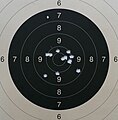Shot grouping
The group on the left measures about 13 mm and was fired at about 45 meters, which equals 13 mm/45 m = 0.29 mils (1⁄2 in group at 50 yards, approx. 1.047′×50/100 = 0.524′).
The group on the right measures about 7 mm and was fired at about 90 meters, which equals 7 mm/90 m = 0.08 mils (0.3 in group at 100 yards, approx. 1.047′×0.3 = 0.314′).
In
Tightness of shot groupings are calculated by measuring the maximum distance between any two bullet holes on the target (center-to-center) in length measurements such as
Uses of the term
For firearms that shoot one round at a time, a shot grouping test can be used to measure the accuracy of the entire shooting system: the weapon's mechanical precision and the uniformity of the ammunition. The weapon is fixed into position on a test mount, and aimed at a target. Multiple shots using rounds from the same type and batch are fired to observe how the weapon groups the shots. If a person holds the weapon and shoots it, the grouping measures the combination of the person's skill and the weapon's accuracy.[2]
In
In archery, a shot grouping is the result of one person shooting multiple arrows at a target. A tight grouping indicates consistency in the archer's form.[4]
Firearms

Mean point of impact (MPI) is the calculated center of the grouping, which is the average center of all the shots, and is not necessarily located at a hole in the target.
A "flier" is a shot from the same shooting session that is distinctly farther from the general grouping, considered to be the outlier of the group. Such shots may be the result of trajectory deviation caused by unexpected changes in wind condition (known as a "wind shift" or "gust"), a muscular flinch of the shooter at the time of the trigger pull, a problem with the firearm mechanism, poor tuning of barrel harmonics, or inconsistency in the ammunition (e.g. bullet/pellet weight and aerodynamics, propellant load and efficiency, muzzle velocity).[6] Infrequent single fliers may be discounted when evaluating large cohorts, but if random fliers occur often, then the problem is considered significant and should be traced to its origin.[2]
While target shooting with a handgun, if a grouping is consistently off-center then the shooter is instructed to alter the body angle or the stance, rather than shifting the arm, wrist or hand, which should remain in position.[7]
Metric units
When using the
By measuring the group size in
And conversely, the group size of 1 milliradian at 100 meters (the default metric sighting-in distance) can be determined just as easily:
Since shot grouping are very small angles, the linear formula above can be used as an extremely good approximation for group sizes in milliradians. The error of assuming that 0.1 mil (the typical click value on mil-based adjustment wheels) equals "10 mm (1 cm) at 100 meters" is about 1×10−7% (or 0.0000001%).
Metric units can also be used to calculate group sizes in
In the above formula, "1000" is the
And conversely:
Therefore, at 100 m, a 1 MOA group can be represented approximately by a 29 mm circle, slightly smaller than a half dollar coin.
Imperial units
When using
By measuring the grouping size as a short
In the above formula, "36" is the
Conversely, the group size of 1 arcminute at 100 yards (the most commonly used sighting-in distance in North America) can also be calculated:
The linear formula above for measuring group sizes using arcminutes with imperial units is less precise than using milliradians with metric units, but can still be a good approximation depending on the demands for precision. When shooting at a target 100 yards away, a 1 MOA group is a circle of approximately 1.047 inch diameter,
Benchmarks
A
Archery
With the increased element of human skill in archery, a grouping on target is more a measure of the archer's skill. If an archer is not getting a consistent grouping, then their basic form needs work. If an archer's arrows are grouping on target but off center, this shows consistent basic form, with better results achievable after slight adjustments.[4][11]
On the equipment side, bow stabilizers have been used since the 1960s by tournament competitors and by bow hunters to counteract the torque of shooting the arrow. A tighter grouping may be achieved with such a stabilizer, which adds mass extending outward on a moment arm, usually mounted perpendicular to the bow riser, aligned with the arrow path.[12][13][14]
Example groupings
-
Handgun and paper target showing grouping of ten shots
-
A grouping made with a five-shot revolver
-
Eight-shot grouping
-
Multiple shots from a semi-automatic handgun
-
Arrow grouping with fairly consistent results but slightly off center
-
Long Range Sniper Rifle Grouping
References
- ^ ISBN 978-0-9722804-2-6.
- ^ ISBN 978-1-4402-3897-0.
- ^ Moller, Cliff. "Understanding Shotgun Chokes, A brief explanation by Briley". Briley Manufacturing. Archived from the original on July 29, 2015. Retrieved August 10, 2015.
- ^ ISBN 978-0-7360-5501-7.
- ISBN 978-0-9707493-9-0.
- ISBN 9781628733006.
- ISBN 978-1-60239-086-7.
- ^ Dexadine Ballistics Software - ballistic data for shooting and reloading
- ISBN 978-0-89689-938-4.
- ISBN 978-0-89689-684-0.
- ISBN 978-1-4504-4468-2.
- ISBN 978-1-62873-012-8.
- ^ Haywood and Lewis 2013, p. 15.
- ISBN 978-0-7360-4634-3.














